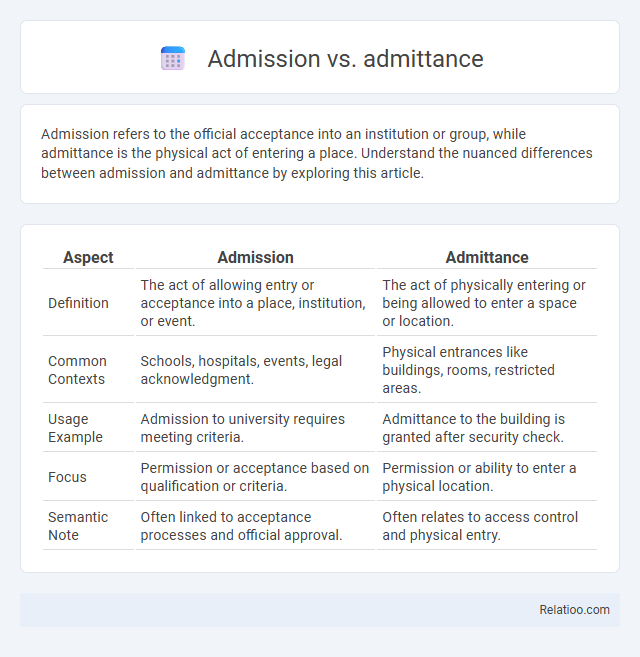Admission refers to the official acceptance into an institution or group, while admittance is the physical act of entering a place. Understand the nuanced differences between admission and admittance by exploring this article.
Table of Comparison
| Aspect | Admission | Admittance |
|---|---|---|
| Definition | The act of allowing entry or acceptance into a place, institution, or event. | The act of physically entering or being allowed to enter a space or location. |
| Common Contexts | Schools, hospitals, events, legal acknowledgment. | Physical entrances like buildings, rooms, restricted areas. |
| Usage Example | Admission to university requires meeting criteria. | Admittance to the building is granted after security check. |
| Focus | Permission or acceptance based on qualification or criteria. | Permission or ability to enter a physical location. |
| Semantic Note | Often linked to acceptance processes and official approval. | Often relates to access control and physical entry. |
Understanding the Terms: Admission vs Admittance
Admission refers to the process or act of being allowed entry into a place, organization, or institution, such as a school or event, while admittance specifically denotes the permission or right to enter. Understanding the distinction helps clarify that admission often involves a formal decision or acceptance, whereas admittance emphasizes the physical or legal allowance to enter. Your grasp of these terms ensures clear communication when discussing access policies or eligibility criteria.
Etymology and Historical Usage
Admission derives from the Latin *admissio*, meaning "a letting in," historically used in legal and formal contexts to indicate permission to enter or acceptance into institutions. Admittance shares a similar origin from the Latin *admittere*, "to send to" or "to allow entry," primarily denoting physical entry or access, frequently employed in architectural and infrastructural contexts. Both terms have evolved with overlapping usage, but admission often emphasizes official acceptance, while admittance focuses on the act of entering a place.
Key Differences in Meaning
Admission refers to the act or process of being allowed entry or acceptance, often used in contexts such as schools, events, or hospitals. Admittance specifically emphasizes physical entry or access to a place or area, frequently related to controlled environments or restricted spaces. Both terms share similarities in granting access, but admission often implies approval or acceptance, while admittance focuses more on physical entry or permission.
Contexts Where ‘Admission’ is Used
Admission commonly refers to the process of being allowed entry into institutions like schools, hospitals, or events, indicating official approval or permission. Your application for university admission highlights acceptance based on qualifications and criteria, distinguishing it from admittance, which often relates to physical entry. In healthcare, admission marks the formal acceptance of a patient for treatment, emphasizing administrative and legal authorization rather than mere access.
Contexts Where ‘Admittance’ is Appropriate
Admittance specifically refers to the act or permission of entering a place or area, often used in physical or restricted space contexts such as "admittance to the building requires an ID badge." You should use "admittance" when emphasizing authorized access or entry, especially in legal, security, or controlled environments. Unlike admission or admittance in academic or general acceptance contexts, admittance highlights the concept of physical entry and permission.
Common Misconceptions and Errors
Admission refers to the process or act of allowing entry, especially into a school, event, or institution, while admittance similarly denotes permission to enter but is often used in more general contexts. Common misconceptions arise when these terms are used interchangeably without regard to their nuanced applications; for example, "admitance" is frequently misspelled or confused but technically refers to the capacity or act of admitting someone or something, though it is less commonly used. To avoid errors, you should use "admission" for formal access or acceptance and "admittance" for physical entry or capability, ensuring clarity in communication.
Usage in Academic Settings
Admission in academic settings refers to the formal process of entering an educational institution, such as universities or colleges, involving application, review, and acceptance. Admittance is commonly used interchangeably with admission, but it often denotes the act of allowing entry or access to specific areas or events within the institution rather than the overall enrollment process. While admittance serves as a synonym for access, admission carries a more formal and comprehensive connotation related to eligibility and acceptance into academic programs.
Usage in Legal and Formal Settings
Admission refers to the formal acceptance of a fact or evidence in legal contexts, often used when a party acknowledges responsibility or a court accepts documentation. Admittance generally denotes permission to enter a place or event and is commonly used in both legal property contexts and formal institutional access settings. Admittance and admission differ in their application; admission aligns with acknowledging truths or legal status, while admittance relates to physical entry or access permissions.
Tips for Choosing the Right Word
Choosing between admission, admittance, and acceptance depends on context and nuance; admission typically refers to permission to enter institutions like schools or events, admittance emphasizes physical entry or access, and acceptance conveys approval or agreement, often in abstract or social contexts. Use admission for formal acceptance scenarios such as college admission processes or ticket admission to events, admittance when discussing entry to restricted areas or physical spaces, and acceptance when highlighting consent, approval, or embracing ideas. Focus on the specific meaning and setting to ensure clarity and precise communication in writing or conversation.
Real-world Examples and Case Studies
Admission refers to the act of being allowed entry, commonly used in contexts like university applications or hospital entries, such as a student's admission to Harvard University. Admittance typically describes physical entry permission, exemplified by restricted admittance to secure facilities like data centers or laboratories. In legal case studies, admission involves acknowledgment of evidence or guilt, influencing outcomes in court rulings and criminal proceedings.

Infographic: Admission vs Admittance
 relatioo.com
relatioo.com